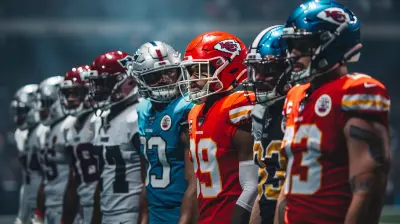Using Data to Improve Team Cohesion and Performance
30 May 2025
When it comes to sports, raw talent and physical fitness aren't always enough to win championships. The greatest teams in history—whether in soccer, basketball, or even esports—have something more: chemistry. The way teammates communicate, support, and work together often plays a bigger role in their success than individual skills alone.
But how do you measure something as intangible as "team cohesion"? And more importantly, how do you improve it? That’s where data-driven insights come into play.
Coaches, analysts, and even players are turning to data science to build stronger, more cohesive teams. By leveraging numbers, statistics, and machine learning, teams can optimize performance and build unstoppable game-time synergy. 
The Role of Data in Sports
Data has revolutionized nearly every aspect of sports, from scouting and injury prevention to in-game tactics and decision-making. But beyond the hard stats—like shooting percentages and sprint speeds—teams are now using data to analyze social dynamics, communication patterns, and overall chemistry.In the past, coaches relied on intuition and observation to gauge a team's cohesion. Now, advanced metrics offer a clearer picture of how players interact, react under pressure, and complement each other on the field. 
How Data Improves Team Cohesion
1. Tracking Player Interactions
The way players communicate—both verbally and non-verbally—plays a major role in team performance. By analyzing factors like:- Pass networks in soccer (who passes to whom, how often, and where on the field)
- Assist patterns in basketball (tracking player tendencies in making plays)
- Mic’d-up conversations in training
...teams can uncover hidden patterns in interpersonal relationships. Do certain players avoid passing to one another? Is there a lack of trust on the field? By identifying these trends, coaches can foster better teamwork and improve overall cohesion.
2. Analyzing Psychological and Emotional Data
Sports psychologists have long emphasized the importance of mental resilience and emotional intelligence in team environments. Now, with advancements in biometric tracking and sentiment analysis, teams can measure aspects such as:- Heart rate variability during stressful moments
- Facial recognition software to analyze emotional responses
- Surveys and self-reported mood tracking before and after games
This data can help coaches detect when certain players are feeling disengaged, frustrated, or overly stressed. By addressing these issues early, teams can prevent conflicts before they arise.
3. Optimizing Team Formations and Tactics
Data-driven analysis allows teams to create configurations that maximize cohesion and efficiency. By studying:- Player movement heat maps (which areas of the field someone covers the most)
- Game simulations (AI-driven analysis of different lineup combinations)
- Workload data (ensuring optimal fitness levels without burnout)
...coaches can assign roles that bring out the best in every player.
For example, in soccer, maybe your best scorer thrives when paired with a particular playmaker. Or in American football, certain offensive line combinations provide better protection for the quarterback. Data-driven insights ensure the right players are matched together.
4. Building Trust Through Transparency
One of the best ways to improve team cohesion is through trust. Players need to trust their teammates, their coach, and the system they're playing in.By using data, coaches can provide objective reasoning for their decisions. If a player is benched or told to adjust their playing style, showing them the actual data behind the decision fosters understanding and buy-in.
Instead of a coach saying, "You're not playing well," they can back it up with metrics:
- "Your defensive pressure is lower than usual in the final 20 minutes."
- "Your pass completion rate drops significantly under high-pressure situations."
When players see the numbers, it removes ego from the equation and builds team-wide trust in the decision-making process. 
Advanced Data Tools for Team Performance
Now that we understand how data can improve team cohesion, let’s look at some of the tech and tools being used behind the scenes.Wearable Technology
Smart jerseys, GPS trackers, and biometric devices monitor movement, heart rate, and fatigue levels. These insights help coaches adjust training intensity and prevent injuries while ensuring players are in peak physical condition.AI and Machine Learning
AI-driven analysis enables teams to simulate different game scenarios, predict outcomes, and even analyze opponent tendencies. Machine learning algorithms can also highlight ideal player pairings based on in-game performances.Video and Performance Analytics Software
Platforms like Hudl, Catapult, and STATSports allow teams to break down game footage, tracking everything from player spacing to reaction times. These tools help athletes fine-tune their decision-making and on-field discipline.Sentiment Analysis and Behavioral Data
Some teams use AI-powered sentiment analysis to assess emotions through body language, tone of voice, and facial expressions. This type of data helps detect hidden tensions or motivations within a team.
Practical Steps to Implement Data-Driven Strategies
Okay, so we know that data can improve team chemistry. But how can teams—whether professional, amateur, or even recreational—start applying these insights?1. Invest in Performance Tracking
Even at the amateur level, teams can leverage affordable wearables and video analysis tools. Something as simple as tracking passes, movement, and energy levels can provide valuable insights.2. Prioritize Communication Data
Encouraging players to self-report their moods, track their social interactions, or analyze game-day communication can reveal patterns that affect team cohesion.3. Use Data to Foster a Growth Mindset
Instead of using numbers to criticize, use them to empower. Show players where they can improve and celebrate their progress. This creates a positive, data-driven culture.4. Continuously Adjust and Adapt
Data isn’t a one-time solution—it’s a continuous process. Teams must consistently collect, analyze, and act on insights to stay ahead.The Future of Data-Driven Team Performance
With advancements in AI, biometrics, and behavioral psychology, the future of data-driven sports performance is brighter than ever.Imagine a world where AI predicts which players are likely to develop strong partnerships before they even train together. Or where virtual reality simulations allow teams to practice specific game scenarios with real-time feedback.
As technology continues to evolve, one thing is certain—data isn’t replacing coaches; it’s enhancing them. The best teams will be the ones who balance hard numbers with human intuition, blending science with the art of teamwork.
Final Thoughts
At the heart of it all, sports are still about people. Data can provide insights, but it’s the trust, chemistry, and camaraderie among teammates that turn good teams into great ones.By leveraging modern analytics, teams can not only fine-tune their tactics but also strengthen the invisible bonds that make championship squads legendary.
So whether you're a coach, athlete, or fan, remember this—numbers don’t lie, but it’s how you use them that makes all the difference.
all images in this post were generated using AI tools
Category:
Team ManagementAuthor:

Everett Davis
Discussion
rate this article
3 comments
Jessica Strickland
Data, often viewed as mere numbers, transcends statistics by weaving narratives of teamwork and synergy. By analyzing player interactions and game dynamics, teams can foster deeper connections, enhancing both individual performance and collective spirit. Ultimately, the heart of the game lies not just in data, but in the bonds it cultivates.
June 19, 2025 at 4:35 AM

Everett Davis
Absolutely! Data reveals stories of collaboration that strengthen team bonds and boost performance, highlighting its vital role beyond mere numbers.
Isla Jones
This article highlights the transformative power of data in sports. By harnessing analytics, teams can identify strengths and weaknesses, fostering better communication and collaboration. It's refreshing to see how data-driven strategies not only enhance performance but also build a stronger, more united team culture.
June 4, 2025 at 2:53 AM

Everett Davis
Thank you for your insightful comment! I'm glad you found the article's focus on data's role in enhancing team cohesion and performance valuable.
Carina McDonough
This article insightfully highlights the pivotal role of data analytics in enhancing team cohesion and performance. By leveraging quantitative insights, teams can identify strengths and weaknesses, ultimately fostering a more collaborative environment and driving success on and off the field.
June 3, 2025 at 10:46 AM

Everett Davis
Thank you for your thoughtful comment! I'm glad you found the article valuable in showcasing how data analytics can boost team cohesion and performance.



